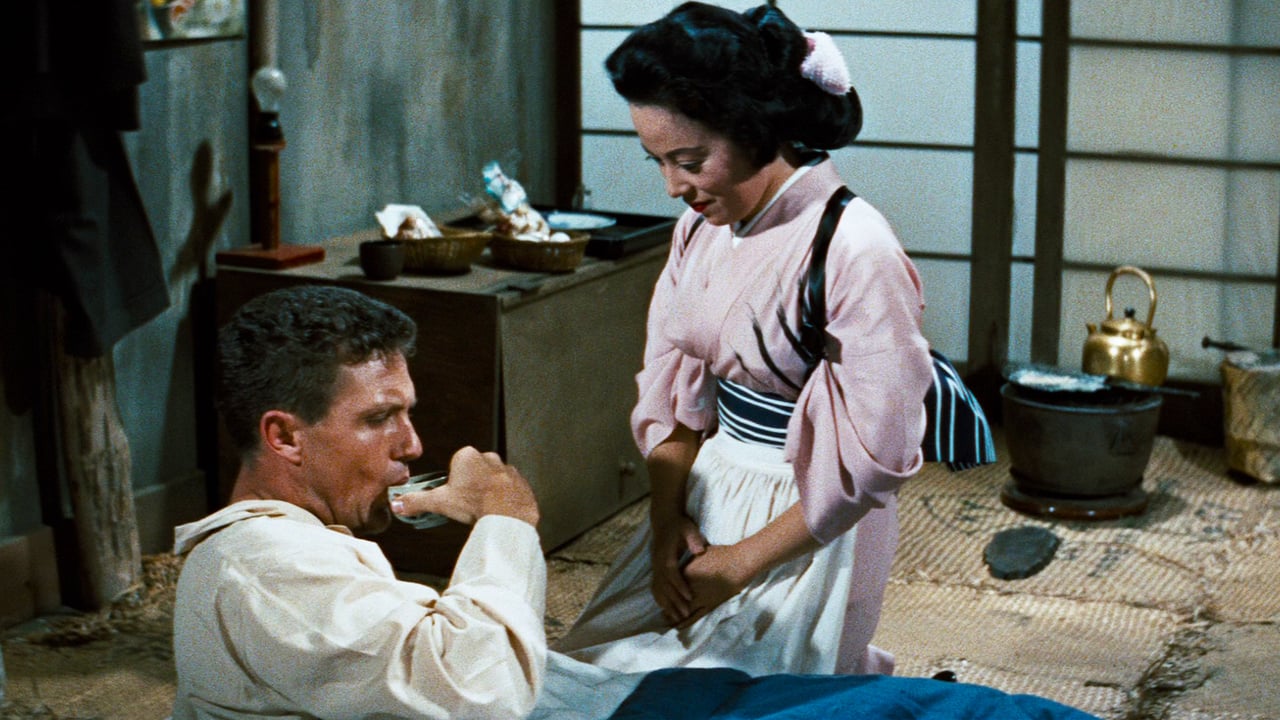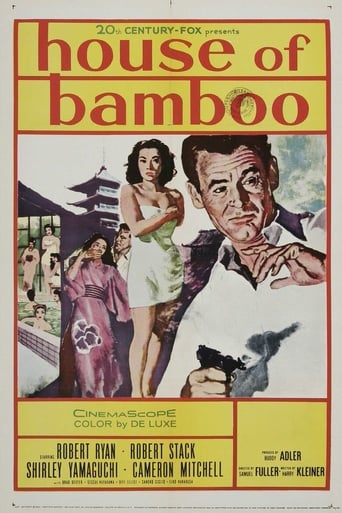LastingAware
The greatest movie ever!
RyothChatty
ridiculous rating
Dorathen
Better Late Then Never
Nessieldwi
Very interesting film. Was caught on the premise when seeing the trailer but unsure as to what the outcome would be for the showing. As it turns out, it was a very good film.
Syl
Robert Ryan and Robert Stack play two American men and veterans from World War II who are now in Japan. There along with other American men, they form their crime gang where they rob, steal, and kill along the way. There is a beautiful woman played by Japanese actress Shirley Yamaguchi in the role. This was filmed ten years after World War II with great location shots. The film has plenty of intrigue, violence, and interest to hold up. I thought the script could use some work. Eddie Spanier (Played by Robert Stack) and Sandy Dawson (played by Robert Ryan) do impressive work in their performances. Stack and Ryan steal the film's scenes. There are colorful moments in this film even with a weak script. The film was beautifully photographed in color.
bkoganbing
House Of Bamboo came out in 1955 three years after the Japanese Peace Treaty effectively ended the occupation of Japan that began post World War II. Americans must have been familiar sight on the streets of Japanese cities still in 1955, we certainly had enough military personnel there. If you don't recognize that fact than you will be puzzled as to how a gang of Americans crooks could operate the way they do in the streets of Tokyo.For those of you who don't recognize it screenwriter Harry Kleiner took the screenplay he wrote for the Henry Hathaway classic, The Street With No Name and set in down in post occupation Japan. Robert Ryan plays the gang leader part that Richard Widmark had. He's recruited a gang of former military misfits who spent more time in the stockade than in combat and made them into an effective heist gang. Ryan's got other interests, but his main income is from some well planned robberies.The USA military intelligence gets involved when Ryan hijacks a train with military hardware and kills a soldier. Going undercover is Robert Stack in the Mark Stevens part. Unlike The Street With No Name, Stack's allowed a little romance here in the person of Japanese actress Shirley Yamaguchi. In The Street With No Name it was Widmark who had the girlfriends and Stevens was strictly business. Sessue Hayakawa is also in the cast as the Japanese police inspector.There's a gay subtext in the film with the relationship of Ryan with his number two, Cameron Mitchell. When Stack starts to take his place in the gang hierarchy, Mitchell reactions are of pure jealousy. In fact Mitchell's reactions are what sets in motion the climax of the film.Which you know if you've seen The Street With No Name. House Of Bamboo boasts some mighty nice location shots of postwar Tokyo which looking at it you would hardly believe what a difference a decade might make. The title House Of Bamboo is the place that Ryan lives in and it's a pre-war structure typical of the Tokyo before General Doolittle inaugurated US bombing raids. Those wooden houses went up like tinder boxes. Note the more modern look Tokyo has in 1955.The color might disqualify House Of Bamboo from the genre, but the film as the look and feel of a good noir film. Which is as good a recommendation as I can give it.
secondtake
House of Bamboo (1955)If you ever wondered if a film noir lead male could just be anyone, that he doesn't need talent beyond being tough and muttering terse nuggets, watch Robert Stack struggle in this film. He tries to pump up all the stereotypes, but he's playacting all the time, and because he's in most of the movie, it falls flat over and over. This is a slow-going, strained movie, and even though it's ambitious in many ways, it will mostly seem routine. All of this took me by surprise, because some of director Samuel Fuller's famous films, like Naked Kiss, are anything but routine.Not that this isn't a gorgeous film. Joe MacDonald is a first rate black and white photographer (film noir and other films), and he applies his visual sense to every scene. All in Cinemascope color! Yes, if you don't mind a relatively dull movie and can just watch, this one is really terrific pageantry. It uses the wide screen better than most, the framing and blocking really worth the ticket alone. And everything is done on location in Japan in the 1950s, just when the country is trying to shed itself of American occupation. Because of this there are many scenes that are almost travelog stuff, and all the streetsides scenes and interiors, the views along the canal and the big overviews at the end, are just superbly photographed.Of course, then you have to ask about all the many films made by Japanese filmmakers at the same time...some of which are not only more authentic, but much better movies all around. There's no use trying to apologize. The acting is totally uneven (the scenes with Robert Ryan come to life, a testimony to his presence and energy), and the plot is dull, lacking a conflict that is clear. There's only so far you can take ambiguous tension in a pretty movie like this. This is a retelling of sorts of a more gripping (and in some ways more formulaic) film, Street with no Name, which is a classic of its type. So kudos absolutely to Fuller for taking this to Japan, and for making it fresh in at least that one sense. We still could benefit from a more tightly conceived scenario, and maybe a less culturally stereotyped view of the city, where sure they had very mixed feelings about brash Americans.MacDonald's photography rules on this on. For example, look at the scene 50 minutes in, and see how simple it is to transform an ordinary conversation to something that has visual sophistication. There's a lot to look at. Keep watching and you'll see more astonishing visuals and set design (if you can call the locations shots that, with smoke pots and running men with tracking camera), all at a gravel pit. Really first rate.
OldAle1
I was pretty excited about another Fuller film after being pleasantly surprised by his first two films seen the previous week, both of which were better than their reputations. Well, everyone has their missteps and this one seems to me to be a minor and fairly pointless film from this great director. A remake of the 1948 B&W noir Street with No Name, this moves the action -- a tale of an undercover cop trying to infiltrate and ultimately take down a big crime boss -- to occupied Japan, widens the screen to 'scope format and adds bright color. Small-time hood Eddie Kenner (Robert Stack) is ostensibly in Japan to make contact with an old friend who turns out to have recently been murdered, perhaps by his own organization, a pachinko parlor cartel run by Sandy Dawson (Robert Ryan). Stack makes friends with the dead man's widow Mariko (Shirley Yamaguchi) and worms his way into Ryan's group which of course turns out to be in business for more than just a few yen from gambling parlors.The action moves reasonably well, and the location shooting is nice (first American film made in Japan, apparently), but it just wasn't gripping to me and far too predictable; the earlier version is better as are quite a number of similar-themed films from the past few years. Worth seeing for Fuller completists, and one of his few color 'scope films, but don't expect anything on the level of Park Row or Pickup on South Street. DVD rental.

